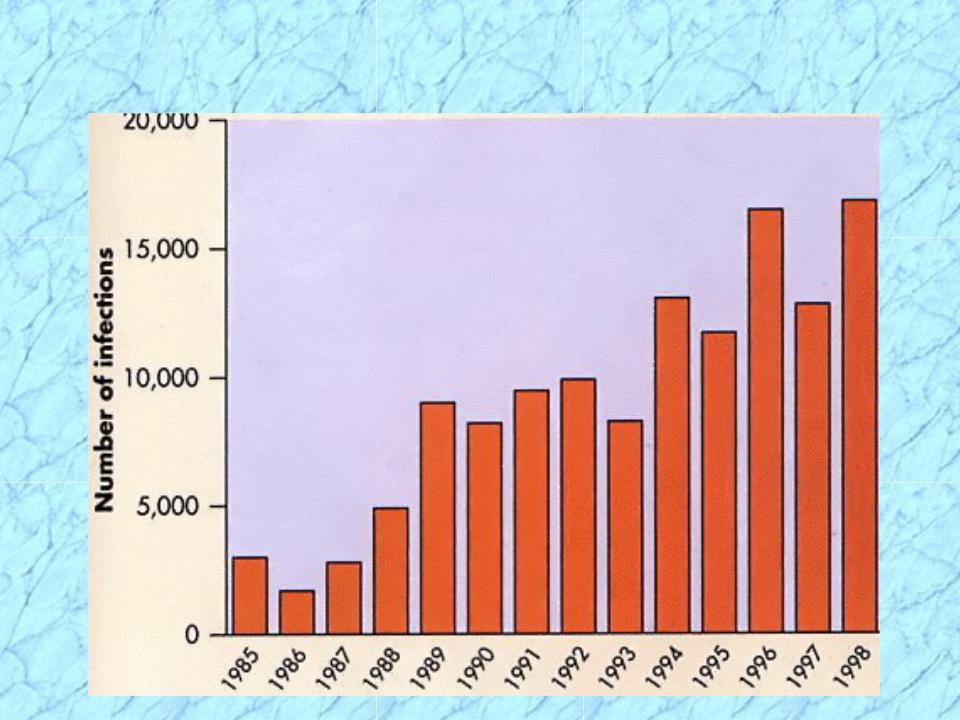
- •Spirochaetales
- •Taxonomy
- •General Overview of Spirochaetales
- •Periplasmic Flagella Diagram
- •Tightly Coiled Spirochete
- •Cross section of
- •Spirochaetales Associated
- •Treponema spp.
- •Nonvenereal
- •Treponema pallidum ssp. endemicum
- •Treponema pallidum ssp. pertenue
- •Treponema carateum
- •Treponema pallidum ssp. pallidum
- •Venereal Treponemal
- •Darkfield Microscopy of
- •General Characteristics of
- •Epidemiology of T. pallidum
- •Incidence of Syphilis in USA
- •Geographical Distribution of
- •Pathogenesis of T. pallidum
- •Virulence Factors of T. pallidum
- •Pathogenesis of T. pallidum (cont.)
- •Pathogenesis of T. pallidum (cont.) Secondary Syphilis
- •Generalized
- •Pathogenesis of T. pallidum (cont.) Latent Stage Syphilis
- •Pathogenesis of T. pallidum (cont.) Tertiary Syphilis
- •Diagram of a
- •Progression of Untreated Syphilis
- •Pathogenesis of T. pallidum (cont.) Congenital Syphilis
- •Comparison of
- •Prevention & Treatment of Syphilis
- •Diagnostic Tests for Syphilis
- •Sensitivity & Specificity of Serologic Tests for Syphillis
- •Review Handout on Sensitivity & Specificity of Diagnostic Tests
- •Conditions Associated with False Positive Serological Tests for Syphillis
- •Effect of Treatment for Syphillis on Rapid Plasma Reagin Test Reactivity
- •Borrelia spp.
- •Giemsa Stain of
- •Epidemiology of Borrelia Infections
- •Borrelia recurrentis & other Borrelia spp.
- •Epidemiology of Relapsing Fever
- •Pathogenesis of Relapsing Fever
- •Clinical Progression of
- •Borrelia burgdorferi
- •Pathogenesis of Lyme Borreliosis
- •Erythema chronicum migrans of
- •Diagnosis of Lyme Borreliosis
- •Bacteria and Syndromes that Cause Cross-Reactions with Lyme Borreliosis Serological Tests
- •Epidemiology of Lyme Borreliosis
- •Incidence of Lyme Borreliosis in USA
- •Leptospira interrogans
- •Silver Stain of Leptospira interrogans serotype icterohaemorrhagiae
- •Leptospirosis Clinical Syndromes
- •Pathogenesis of Icteric Leptospirosis
- •Clinical Progression of Icteric (Weil’s
- •Epidemiology of Leptospirosis
- •Comparison of Diagnostic Tests
- •REVIEW
- •General Overview of Spirochaetales
- •Periplasmic Flagella Diagram
- •Spirochaetales Associated
- •Review of
- •Summary of
- •Summary of
- •Nonvenereal
- •Review of Treponema pallidum
- •General Characteristics of
- •Epidemiology of T. pallidum
- •Pathogenesis of T. pallidum
- •Virulence Factors of T. pallidum
- •Pathogenesis of T. pallidum (cont.)
- •Pathogenesis of T. pallidum (cont.) Secondary Syphilis
- •Pathogenesis of T. pallidum (cont.) Latent Stage Syphilis
- •Pathogenesis of T. pallidum (cont.) Tertiary Syphilis
- •Diagram of a
- •Progression of Untreated Syphilis
- •Progression of Untreated Syphilis
- •Pathogenesis of T. pallidum (cont.) Congenital Syphilis
- •Prevention & Treatment of Syphilis
- •Diagnostic Tests for Syphilis
- •Review Handout on Sensitivity & Specificity of Diagnostic Tests
- •Analytic Performance
- •Analytic Performance
- •Review of Borrelia
- •Summary of
- •Summary of
- •Epidemiology of Borrelia Infections
- •Review of Borrelia recurrentis
- •Epidemiology of Relapsing Fever
- •Pathogenesis of Relapsing Fever
- •Review of Borrelia burgdorferi
- •Pathogenesis of Lyme Borreliosis
- •Diagnosis of Lyme Borreliosis
- •Epidemiology of Lyme Borreliosis
- •Review of Leptospira
- •Summary
- •Summary
- •Leptospirosis Clinical Syndromes
- •Pathogenesis of Icteric Leptospirosis
- •Epidemiology of Leptospirosis

Bacteria and Syndromes that Cause Cross-Reactions with Lyme Borreliosis Serological Tests

Epidemiology of Lyme Borreliosis
Lyme disease was recognized as a syndrome in 1975 with outbreak in Lyme, Connecticut
Transmitted by hard body tick (Ixodes spp.) vectors
•Nymph stage are usually more aggressive feeders
•Nymph stage generally too small to discern with unaided eye
•For these reasons, nymph stage transmits more pathogens
White-footed deer mice and other rodents, deer, domesticated pets and hard-shelled ticks are most common reservoirs

Incidence of Lyme Borreliosis in USA


Leptospira interrogans

Silver Stain of Leptospira interrogans serotype icterohaemorrhagiae
Obligate aerobes
Characteristic hooked ends
(like a question mark, thus the species epithet – interrogans)

Leptospirosis Clinical Syndromes
Mild virus-like syndrome
(Anicteric leptospirosis) Systemic with aseptic meningitis
(Icteric leptospirosis) Overwhelming disease (Weil’s disease)
Vascular collapseThrombocytopeniaHemorrhage
Hepatic and renal dysfunction
NOTE: Icteric refers to jaundice (yellowing of skin and mucus membranes by deposition of bile) and liver involvement

Pathogenesis of Icteric Leptospirosis
Leptospirosis, also called Weil’s disease in humans
Direct invasion and replication in tissues
Characterized by an acute febrile jaundice & immune complex glomerulonephritis
Incubation period usually 10-12 days with flu-like illness usually progressing through two clinical stages:
i.Leptospiremia develops rapidly after infection (usually lasts about 7 days) without local lesion
ii.Infects the kidneys and organisms are shed in the urine (leptospiruria) with renal failure and death not uncommon
Hepatic injury & meningeal irritation is common

Clinical Progression of Icteric (Weil’s
Disease) and Anicteric Leptospirosis
(pigmented part of eye)

Epidemiology of Leptospirosis
Mainly a zoonotic disease
•Transmitted to humans from a variety of wild and domesticated animal hosts
•In USA most common reservoirs rodents (rats), dogs, farm animals and wild animals
Transmitted through breaks in the skin or intact mucus membranes
Indirect contact (soil, water, feed) with infected urine from an animal with leptospiruria
Occupational disease of animal handling
